Atomic torpedo and multipurpose submarines. Projects 705, 705А, 705Д
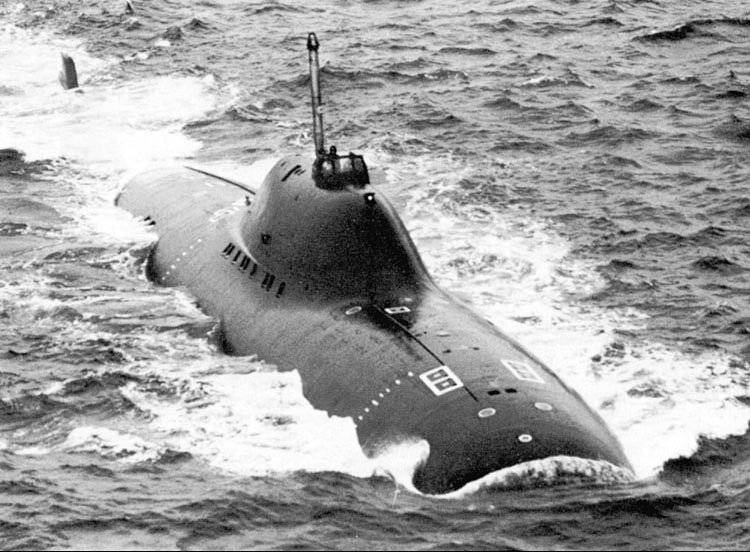
At SKB-142 (Leningrad), along with work on nuclear-powered projects 627, 645 and 671, an energetic search was made for unconventional, new ones. solutions that can provide a qualitative breakthrough in the development of domestic submarine construction. In the 59 year, A. B. Petrov, one of the specialists of SLE, proposed the creation of a compact single-shaft complex-automated high-speed nuclear submarine with a reduced crew. New ship, according to the developer, a kind of "underwater fighter-interceptor." Having a submerged speed of more than 40 nodes, was able in an extremely short time to reach a given point to attack the surface or underwater enemy. With the timely detection of the enemy's torpedo attack, the nuclear submarine had to escape from the torpedoes, making a preliminary salvo from the TA.
The low displacement of the submarine (about 1,5 thousand tons), in combination with a high-powered power plant, should have ensured high maneuverability and quick set speed. The nuclear-powered ship was supposed to depart from the mooring wall in a few minutes, turn around in the water area, and also leave the base to solve the combat mission, and after returning - to moor independently.
After a rather heated debate, in which representatives of industry and the navy participated fleet, as well as making a number of significant changes to the project, the idea of such a nuclear submarine was supported by the military and the leadership of the Ministry of Industry and Trade. In particular, B.E. Butoma, Minister of the Shipbuilding Industry and S.G. Gorshkov, Commander-in-Chief of the Navy.
Those. The project proposal was prepared at the beginning of 60, and a joint resolution of the Council of Ministers of the USSR and the CPSU Central Committee on the design and construction of the submarine of the 23 project was issued on 705 in June of the same year. 25.05.1961 appeared another decree, which allowed the chief designer of the project and scientific management to deviate from the rules and regulations of military shipbuilding with sufficient justification. This “untied the hands” of the creators of the nuclear submarine and made it possible to embody the most courageous technical solutions ahead of their time in the design.
The work on the 705 project was headed by the chief designer Rusanov (in 77, he was replaced by Romin). General management of the program was entrusted to Academician Aleksandrov. K.I. Martynenko and V.V. Gordeev - the main observers from the Navy. The creation of the nuclear submarine of the 705 project was, according to D.F. Ustinov, secretary of the Central Committee of the CPSU who oversaw the defense industry, "a national task." Powerful scientific forces were involved in the program, for example, academicians A.G. Iosifyan and V.A. Trapezniki.
The greatest difficulty during the design of the submarine of the 705 project was to maintain the displacement of the vessel within 1,5 - 2 thousand tons and achieve high speeds.
To achieve a given speed in 40 nodes with a limited displacement, a highly stressed power plant with high aggregate power was needed. After researching the various schemes of the main power plant (in particular, they considered a gas reactor that ensured the operation of a gas turbine), it was decided to stop at a one-reactor power plant with a liquid metal coolant and increased steam parameters. As shown by calculations, a plant having a liquid-metal coolant compared with the main power plant having a traditional water-to-water reactor, could save 300 tons of displacement.
A proposal to create, specifically for a submarine of the 705 project, a two-circuit one-reactor steam generating plant of the PUH type of a boat of the 645 project came from OKB Gidropress in 60. Soon a government decision was taken to develop such a facility. Academician A.I. was appointed scientific supervisor. Leipunsky.
At the same time, two alternative types of nuclear power plants were designed: OKB Gidropress created BM-40 / А (two-section, block, two circulation pumps and two steam lines, chief designer V.V. Stekolnikov), and Gorky OKBM OK-550 (block, communications of the primary circuit are branched, with three circulating pumps and three steam lines, the head is I.I. Afrikanov).
A titanium alloy, which was developed by the Central Scientific Research Institute of Metallurgy and Welding - project leader Academician I.V. Gorynin. Titanium alloys were used in the manufacture of ship systems and other structural elements.
For the nuclear submarine of the 705-th project, new technical and military means were created based on the latest achievements of science and technology of 1960-s, which had improved weight and size characteristics. To keep within the framework of those. mission, it was necessary to reduce the crew of the submarine to a level that would correspond to the crew of strategic bombers 1940 — 1950-s. As a result, they made a revolutionary decision for that time to create an automated integrated control system for the nuclear submarine. In the central design office of the plant. Kulakov (today - the Granit Research Institute) for ships created a unique combat information and control system (BIUS) Accord, which made it possible to concentrate the control of the submarine at the central post.
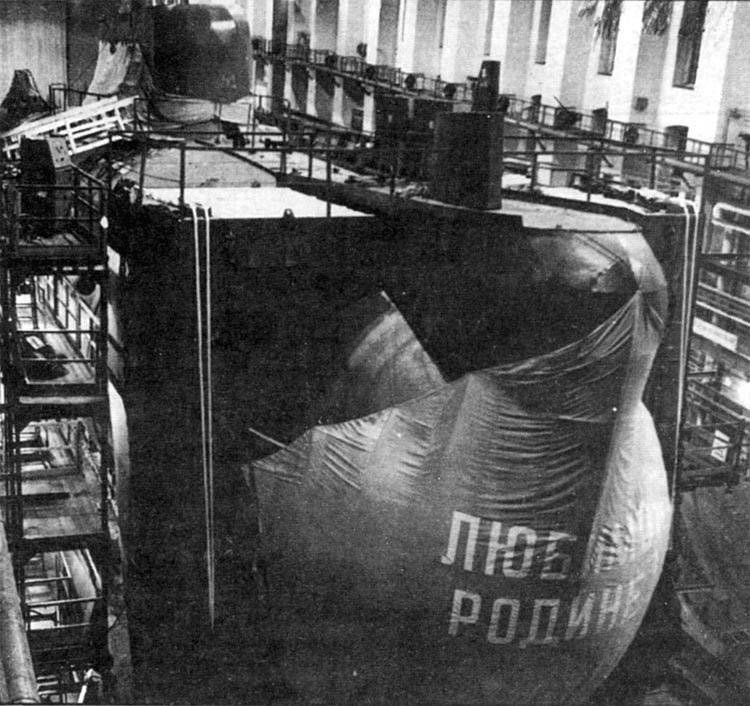

During the design, the number of compartments of the robust hull increased from three to six, the displacement increased one and a half times. Changed the size of the crew of the submarine.
Initially it was assumed that the crew would consist of 16 people, but later, at the request of the navy, the number was brought to 29 people (4 midshipman and 25 officers).
Reducing the crew has led to more stringent requirements put forward to the reliability of the equipment. The tasks were to eliminate the need for equipment maintenance during the voyage.
Thorough testing of the hydrodynamic contours of the hull of the submarine were scientists of the Moscow branch of TsAGI them. Zhukovsky under the guidance of Fedyaevsky. Measures were taken to reduce the physical fields of the submarine, as well as to increase its explosion resistance due to more efficient depreciation and new design solutions.
It was decided to use alternating current electrical equipment of frequent 400 Hz (on domestic nuclear submarines of other 50 Hz projects), which ensured the improvement of the weight and size characteristics of the equipment.
The construction of the experimental submarine of the 705 project (received the designation K-64) from the OK-550 nuclear power plant, which was supposed to become a prototype for a large series of anti-submarine submarines, was launched on 2 on June 1968 in the slipway of the Leningrad Admiralty Association. 22 April 1969, the ship was launched. At the end of 71, it arrived at Western Person on the base and on December 31 was commissioned by the Northern Fleet, becoming part of the first fleet of the third submarine division.
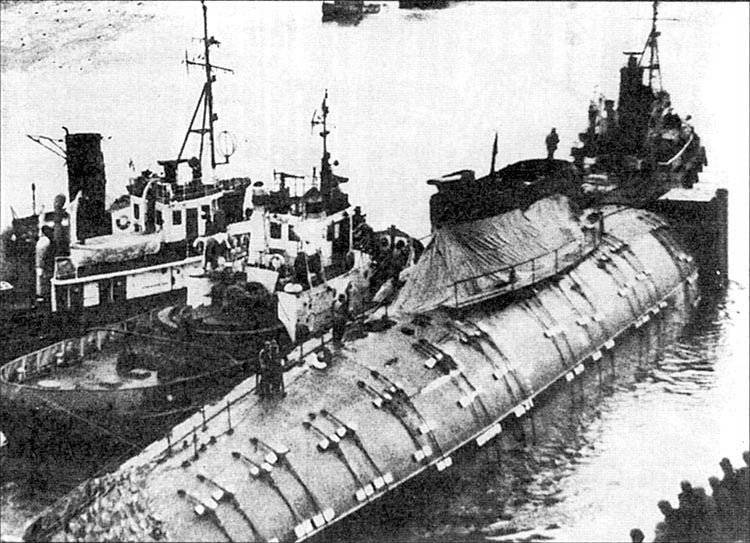
The first commander of the unique nuclear submarine was Captain First Rank A.S. Pushkin.
However, the submarine pursued failures. During mooring tests one of the autonomous loops of the primary circuit failed. The second loop failed in the initial period of operation. Identified and cracking titanium welded hull.
Despite this, in 72, we passed the course task No. 1. In preparation for going to sea, in order to complete the coursework problem No. XXUMX, the process of solidification of the coolant in the primary circuit began. All accident prevention measures were unsuccessful. As a result, the coolant froze completely, and the reactor was silenced.
K-64 19 August 74 of the year removed from service. In 1972, it was decided to suspend work on the laid submarines of the 705 project until the causes of accidents in the primary circuit of the reactor were clarified and eliminated.
The failure of the lead submarine delayed the implementation of the program for a long time, but did not lead to a cessation. In Leningrad and Severodvinsk, work began on the construction of a series of advanced submarines of the 705K project (Lyra):
Nuclear submarines of the 705K project built on the NSR:
K-123 - bookmark 22.12.67, launching 04.04.76, acceptance date November 77;
K-432 - bookmark 12.11.67, launching 03.11.77, date of acceptance January 79-th;
K-493 - bookmark 21.01.72, launching 21.09.80, acceptance date September of 81;
Nuclear submarines of the 705K project built on LAO:
K-316 - bookmark 26.04.69, launching 25.07.74, acceptance date September of 78;
K-373 - bookmark 26.06.72, launching 19.04.78, acceptance date November 79;
K-463 - bookmark 26.06.75, launching 30.04.81, acceptance date December of 81.
The last, the seventh ship in the series, was dismantled on the stocks. Unlike the 705 project, where the PPU OK-550 was installed, the steam generating installation BM-705А was used on the 40K project.
The submarines of the 705 and 705K projects were designed to destroy enemy submarines during their exit from the bases, at the sea crossing and at positions of intended use weapons against objects on the shore. Submarines could be attracted to destroy surface ships and enemy transports in all regions of the world’s ocean, up to the Arctic.
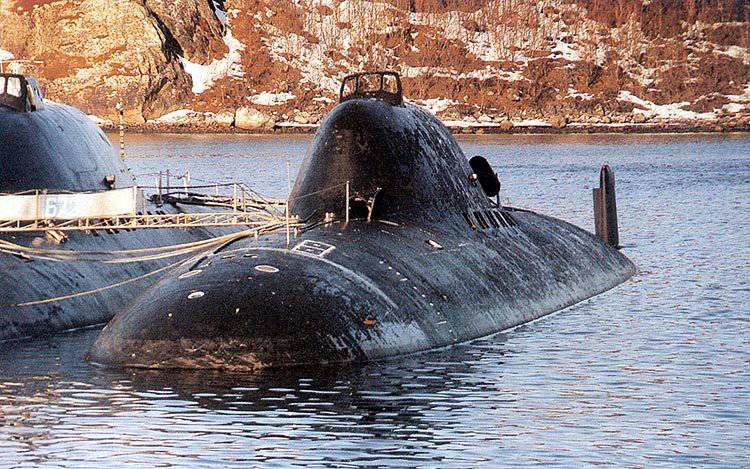
Submarine project 705 (705K) - single-shaft, double-hull. The body, made of titanium alloy, was a rotational body along the entire length. The felling of the felling is of a “limousine” type (the contours which smoothly mated with the contours of the hull of the vessel were worked out by the hydrodynamics of the Central Aerohydrodynamic Institute). The robust housing was divided into six watertight compartments by transverse bulkheads. The third compartment, where the service and living quarters and the main command post were located, was limited to spherical bulkheads, which are designed for full outboard pressure.
The boat was equipped with a floating cabin (for the first time in the world), designed to save the entire crew during the ascent from the depth limit, with large values of trim and heel.
PPU BM-40А (150 thous. KW) - one-pot type. The primary coolant was a eutectic alloy of lead and bismuth. Steam turbine unit OK-7K - block construction, single-shaft.
The boat was equipped with two auxiliary propulsion complexes (each of 100 kW), placed in horizontal stabilizers in hermetic gondolas and equipped with propellers with rotating blades.
There were two synchronous generators of three-phase alternating current (1500 kW, 400 Hz, 400 B). Each generator is supplied with energy by consumers of its own side. There is an auxiliary diesel generator set (300 V, 500 kW) and an emergency battery pack consisting of 112 elements.
Management of the submarine, its technical and military means is carried out from the main command post. Comprehensive automation provides a solution to the problems of using weapons, collecting and processing tactical information, reproducing the external situation, combat maneuvering, ship navigation, remote and automatic control of traffic and technical means.
The keeping of permanent watches for individual devices and mechanisms was not provided for; When 1 and 2 were ready, they only made periodic visits to maintenance-free watch bays. In real life combat shift was limited to eight crew members.
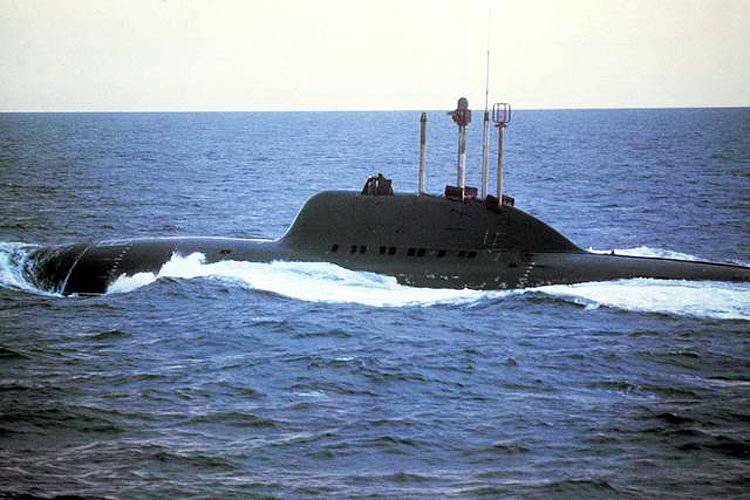
For automatic, manual and programmed control of the movement and stabilization of a nuclear submarine on the course on the go, according to the depth of immersion (without running and on the go) served the system "Bauxite". On the move, automatic trimming was done using the “Tan” system. The management and control of the operation of the power plant, as well as the general ship devices and systems and the electric power system were provided by the Rhythm system.
Also, the submarine was equipped with:
- Accus (combat information management system) "Accord";
- automated complex GAS "Ocean";
- The Sargan automatic weapon control system;
- automated system of autonomous means of navigation "Sozh";
- automated system of radio communications "Lightning";
- automatic radiation monitoring system "Alpha";
- radar station "Bay";
- TV-optical complex TV-1;
- Platan single time system;
- universal periscope "Signal";
- the system of ship intercommunication "Ellipsoid".
Sanitary, medical and living quarters were located on the middle deck of the third compartment, provision rooms and a galley on the lower deck. In the mess-room, they can eat at the same time up to 12 crew members.
Torpedo armament consists of six hydraulic torpedo tubes located in the bow of the submarine. Ammunition - 18 torpedoes.
Technical characteristics of the nuclear submarine project 705K:
The greatest length - 81,4 m;
The greatest width - 10,0 m;
Draft on KVL - 7,6 m;
Normal displacement - 2300 m3;
Full displacement - 3100 m3;
Reserve buoyancy - 37%;
Immersion depth - 400 m;
Full submerged speed - 41,0 node;
Surface speed - 14,0 nodes;
Autonomy - 50 days;
Crew - 32 person.
In December, 77 year, after the completion of the factory and state. tests, the submarine K-123 under the command of second-rank captain A.Ch. Abbasova began to work out coursework tasks of combat training for entry into the composition of the permanent readiness forces of the Northern Fleet. In the 84 year for the successful development of a new type of vessel A.Ch. Abbasov was awarded the title Hero of the Soviet Union, A.S. Pushkin was awarded the Order of Lenin.
New nuclear submarines, which received the nickname "automatic" with the sailors, the "potential enemy" - the name Alfa, became quite popular boats in the fleet. The record high performance of the submarine (however, they were reliably known only to a narrow circle of “initiates”) and the aesthetic perfection of submarine forms made a strong impression.
Having a maximum travel speed that is comparable to the speed of universal and anti-submarine torpedoes of “potential adversaries”, the nuclear submarine of the 705 project (705K), thanks to the characteristics of the power plant (no special transition to the higher parameters of the main power plant was required when the speed increased; with water reactors), were able to develop a full stroke in minutes, having almost "aircraft" acceleration characteristics. Significant speed allowed for a short time to enter the “shadow” sector of the underwater or surface ship, even if Alpha was previously detected by the enemy’s hydroacoustics.
According to the memoirs of Rear Admiral Bogatyrev, who in the past was the commander of K-123 (project 705K), the submarine could turn around "on the patch", which is especially important during active tracking of the "enemy" and its submarines one after another. Alpha did not allow other submarines to enter the course feed corners (i.e., in the zone of sonar shadow), which are particularly favorable for tracking and delivering sudden torpedo attacks.
High maneuverability and speed characteristics of the nuclear submarine of the 705 project made it possible to work out effective maneuvers of evading enemy torpedoes with further counterattack. In particular, the submarine could be circulated at 180 degrees at maximum speed and, after 42 seconds, could begin to move in the opposite direction. The commanders of nuclear submarines project 705 A.F. Zagryadsky and A.U. Abbasov said that such a maneuver made it possible, while gradually increasing the speed to the maximum and at the same time making a turn with a change in depth, to force the enemy following them in the direction-finding mode to lose target, and to the Soviet nuclear submarine to go "at the fighter".
The submarine hull contours provided minimal reflection of the hydroacoustic signal. This made it difficult for the Alpha to attack the enemy using the sonar system in active mode.
But during the operation of the submarines of the 705 project, significant shortcomings appeared that prevented their effective use. In particular, there were serious difficulties with the provision of the base of the boat (due to the need for constant support in the hot state of the primary circuit of the reactor). Were required regular special operations to prevent oxidation of the coolant, periodic regeneration and constant monitoring of the state of the alloy. Many operational issues have also proven to be intractable. In particular, they failed to implement the idea of creating two nuclear-submarine crews, the “sea” and the “coastal”, which ensure the operation and maintenance of the submarine while it is at the base. As a result, the career of the Alpha boats, despite the unique advantages of the vessels, turned out to be relatively short. “Zakat” was also promoted by the notorious restructuring, which led to the fact that the sun began to lose funding.
The submarine K-123 went down in history as a submarine with the longest overhaul in the history of the domestic submarine fleet, which lasted more than nine years - from June 83 of the year to August of 92. In July, 97 of the year this vessel was excluded from the fleet. Other Alphas were expelled from the Navy much earlier - in 90.
It should be noted separately that over the years of 20 operation on the submarines of this project in the struggle for survivability have not lost a single person.
705A project
In the 62-th year, on the basis of the 705-th project, the high-speed torpedo submarine with a ZhMT reactor at SKB-143 performed the pre-sketch project 705A submarines equipped with the Amethyst anti-ship complex with an underwater launch.
Six inclined containers with cruise missiles were to be placed in a developed felling fence with a "limousine" shape, as well as in the upper part of the add. compartment, which is "embedded" in a solid submarine hull in front of the reactor compartment. Other elements of the weapons and design of the project 705A repeated the corresponding elements of the 705-th project. However, in parallel with the option that had a body made of titanium alloy, they were working on a version having a strong steel case, which had a much larger normal displacement component 4085 м3.
A two-part submarine, made of titanium alloys, was to be equipped with a main power plant with a capacity of 40 thousand liters. with. having one liquid metal reactor. Provided a pop-up rescue chamber that can accommodate the entire crew of the submarine (similar to the project 705). Torpedo armament consisted of 6 torpedo tubes of caliber 533 mm with an ammunition 18 torpedoes.
Technical characteristics of SSGNs of 705А project (version with titanium case):
The greatest length - 81,0 m;
The greatest width - 8,0 m;
Normal displacement - 2385 m3;
Extreme depth of immersion - 400 m;
Full submerged speed - 37,0 nodes;
Surface speed - 8,0-10,0 nodes;
Autonomy - 50 days;
Crew - 24 person.
However, work on the creation of the submarine of the 705A project did not receive any practical implementation (the delay in creating its prototype, the torpedo submarine of the 705 project, had an effect). A further continuation of this direction was the 686 project.
Project XNUMHD
In SKB-143 prepared initiative proposals for 705, in which the reactor on the liquid-metal fuel was to be replaced by a water-water reactor. However, these proposals did not receive support.
In those. IPPE certificate on the analysis of operational experience of nuclear power plants with ZhMT, which was prepared in 98, says that today such installations can and should also be considered on a competitive basis together with steam generating water installations for use in nuclear submarines near and distant perspective.
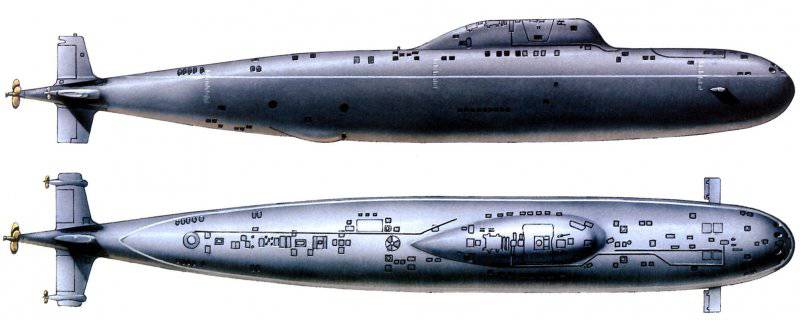
Information